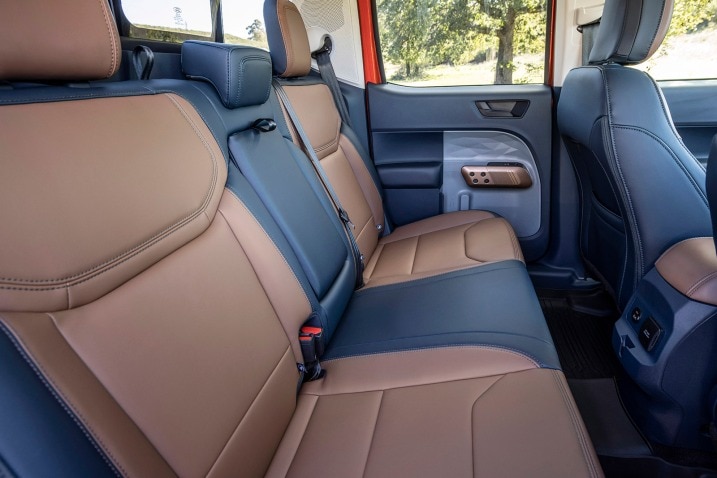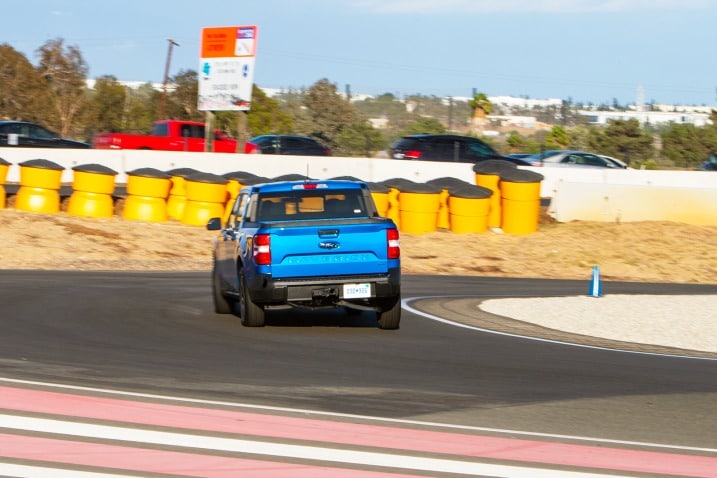- The 2022 Ford Maverick joins the Hyundai Santa Cruz in the revived small truck segment.
- These new small trucks are based on small SUVs, and the Maverick shares its platform with the Ford Escape.
- The midsize Ford Ranger may have more truck cred, but if you don't actually need all that truck capability, the Maverick is a quicker, more nimble and more fuel-efficient option.
TESTED: Can the 2022 Ford Maverick Keep Pace With the Hyundai Santa Cruz?
The results were closer than we expected
If you're someone who longs for the days when small pickup trucks were actually, you know, small, then you've probably been waiting with bated breath for the arrival of the Ford Maverick and Hyundai Santa Cruz. Well, they're finally here, and unlike a lot of today's inflated midsize trucks, they're rather likely to fit in your garage.
Like the Santa Cruz, the Maverick isn't built like a typical truck with a body-on-frame foundation. Instead, it repurposes one of Ford's car-like crossover SUV platforms shared with the Escape, which means that the Maverick, like the Santa Cruz, is at heart a front-wheel-drive vehicle. With a 4.5-foot bed extending off the back of its modestly sized cabin, which technically seats five, the Maverick not only has a slightly longer bed than the Santa Cruz, but its styling also looks more convincingly truck-like.
So it has the looks and a half-foot bed length advantage, but how does the Maverick stack up against its closest and only competitor? We took one to our test track to find out.
How does the Maverick perform?
We tested a Maverick in top Lariat trim with the stronger turbocharged 2.0-liter engine. Power output for this four-cylinder is said to be 250 horsepower with 277 lb-ft of torque, a nice bump of 59 hp and 122 lb-ft over the standard hybrid engine, but less power and torque than what the Santa Cruz's slightly larger 2.5-liter turbo engine is pushing. Our truck also had all-wheel drive, which is an option you can only get with the upgraded engine, and it comes exclusively with an eight-speed automatic.
Rolling up onto our scales at the test track, this fully loaded Maverick weighed in at 3,767 pounds, which is significantly lighter than the comparably specced Santa Cruz we tested at 4,128 pounds, and only slightly heavier than a Ford Escape with the same powertrain at 3,675 pounds.
Test Car | Test Date | Weight | Acceleration 0-60 | Acceleration 1/4-Mile | Braking distance 60-0 | Skidpad |
|---|---|---|---|---|---|---|
| 2022 Ford Maverick Lariat 2.0T AWD | 10/18/21 | 3,767 lbs | 6.4 sec | 14.7 sec @ 92.6 mph | 119 ft | 0.80 g |
| 2022 Hyundai Santa Cruz Limited 2.5T AWD | 09/20/21 | 4,128 lbs | 6.5 sec | 14.6 sec @ 95.9 mph | 119 ft | 0.85 g |
| 2020 Ford Escape SEL 2.0T AWD | 06/15/20 | 3,675 lbs | 6.9 sec | 15.0 sec @ 92.8 mph | 127 ft | 0.82 g |
| 2019 Ford Ranger XLT FX4 | 12/17/18 | 4,521 lbs | 6.8 sec | 15.1 sec @ 90.5 mph | 138 ft | 0.77 g |
From the driver's seat, the Maverick feels peppy and slightly more eager at lower speeds than the Santa Cruz. Although it has less power and torque than the Hyundai, it also rolls around with 361 fewer pounds, helping it make the sprint to 60 mph in a brisk 6.4 seconds and beat the Santa Cruz by a whisker. We employed the typical power-braking technique — pressing both the brake and accelerator pedals at the same time — to take the slack out of the launch, which is necessary for the Maverick to get the jump on the Santa Cruz. The transmission upshifts pretty quickly for the first two gears and then slows noticeably for the 3-to-4 shift. Unlike in the Santa Cruz and its paddle-shift-equipped dual-clutch transmission, there's no way to manually select gears in the Mav. Instead what you get is an L mode, which helps keep the transmission in a lower gear to maximize available torque, but this does nothing to improve acceleration times. When both mini trucks get to the quarter-mile mark, the Santa Cruz has taken the lead and is beginning to leave the Maverick in its wake.
Things get a little more interesting comparing the Maverick to the Ford Escape, which has the same powertrain and tires but is slightly lighter than the Mav, giving it a potential speed advantage. Or so we thought. On its best run, the Escape only managed a 6.9-second 0-60 mph time and a quarter-mile time of 15 seconds at 92.8 mph, trailing the Maverick on all counts except speed at the quarter mile. So what do we think happened here?
One reason could be the difference in weather conditions. At the time of the Escape's quick run, the ambient temp was 76 degrees. The Maverick enjoyed testing temps 10 degrees cooler with more favorable atmospheric conditions, so its engine was likely producing more power. Additionally, because the Maverick is set up for truck duty, it gets a higher final drive ratio (3.63:1) versus the Escape's (3.47:1), which means more torque at the wheels and better low-end acceleration.
But wait, there's more! If you have the Maverick's 4,000-pound tow package, as our test car did, you get an even higher final drive ratio of 3.81:1. This gearing difference alone means our Maverick test car produced about 9.8% more torque at the wheels than our Escape test car did.
So the Maverick and Santa Cruz are pretty close in terms of acceleration, but how about braking and handling? Well, in our panic-stop test from 60 mph, they are dead even down to the foot, both getting it done in a respectable 119 feet. Each truck wears its own flavor of Michelin-brand all-season tires, but the Santa Cruz's are slightly wider 245-mm wide tires to the Mav's 225-mm rubber. The extra tire width likely played a factor in skidpad performance — the Maverick wasn't able to match the Santa Cruz's average of 0.85 g, only mustering a mediocre 0.80 g average on its best lap.
While skidpad numbers don't always paint the full picture, the Mav's relatively mediocre road-holding performance pretty much translates to its handling experience as a whole. If Ford's intention was to make this handle and feel like a smaller truck, it's succeeded. The Maverick's size still lends some natural nimbleness, which makes it better to drive than a midsize Ford Ranger, but it feels much less composed and its body less rigid than the Santa Cruz, which doesn't handle like a truck in the least.
What kind of hardware is the Maverick packing?
The Ford Maverick is available with two engines. The optional 2.0-liter EcoBoost you already know about, but the base engine is actually a hybrid powertrain, using a naturally aspirated 2.5-liter inline-four paired to continuously variable transmission sending power solely to the front wheels. This engine makes relatively anemic 162 horsepower and 155 lb-ft of torque, but it gets a power boost thanks to the electric motor for a total combined output of 191 hp. This fuel-saving setup is estimated to return an incredible 43 mpg in the city, 33 mpg on the highway and 37 mpg in combined driving. By comparison, our 2.0-liter test truck is rated at 22 mpg city, 29 highway and 25 mpg combined.
In sharing its underpinnings with the Ford Escape, the Maverick employs a MacPherson strut front suspension, a twist-beam rear suspension for the front-drive versions and an independent trailing-arm multilink rear suspension for the models with all-wheel drive. Traditional body-on-frame trucks typically employ a solid rear axle with leaf springs, which is why they typically ride and handle the way they do. Seventeen-inch wheels are standard, but the optional 18-inch wheels are what came on our test car along with 225-millimeter-wide Michelin Primacy A/S all-season tires and disc brakes at all four corners.
According to Ford, even the base-engine Maverick can tow up to 2,000 pounds and has a maximum payload capacity of 1,500 pounds. As the saying goes, just because you can doesn't mean you should.
Edmunds says
The Ford Maverick may not match the Santa Cruz in all aspects of performance, but if you're looking for a small truck that gets incredible fuel economy, or that delivers more of a conventional truck look and feel, then the Maverick may be the one to get. Either way, we're glad to see some trucks that'll finally fit in the garage again.








 by
by